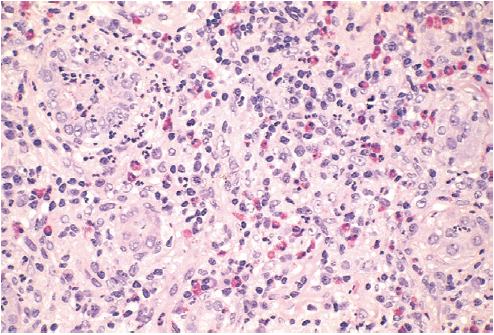Interstitial nephritis pathophysiology
Overview
It is thought that acute interstitial nephritis is mediated by hypersensitivity reaction to endogenous or exogenous antigens expressed by tubular cells. Numerous drugs such as antibiotics, NSAIDS, sulfa-containing drugs, etc, as well as systemic diseases, and Infections may lead injury to renal cells. the cascade activation owing to cellular injury toward inflammatory cell infiltration, and activation of cytokines causes an immunologic reaction in acute or chronic process.
In acute interstitial nephritis, this cascade activation can cause renal tubular dysfunction, whereas in chronic interstitial nephritis an insidious interstitial fibrosis,scarring, , and tubular atrophy spreads gradually and causes progressive chronic renal insufficiency.
Pathophysiology
Physiology
drugs have emerged as an important cause of renal injury.
Acute drug-induced tubulointerstitial nephritis (TIN) occurs as an adverse reaction to any of an increasing number of drugs such as: penicillins, rifampin, diuretics (thiazides), nonsteroidal anti-inflammatory agents, and numerous other drugs like phenindione, cimetidine.
Pathogenesis
Many features of the disease suggest an immune mechanism. Clinical evidence of hypersensitivity includes latent period, eosinophilia and rash, the idiosyncratic nature of the drug reaction (i.e., the lack of dose dependency), and the recurrence of hypersensitivity after reexposure to the same drug
or others that are similar in structure. Serum IgE levels are increased in some persons, suggesting type I hypersensitivity.
In other cases the nature of the inflammatory infiltrate (discussed below) and the presence of positive skin tests to
drugs suggest a T cell–mediated (type IV) hypersensitivity reaction.
The most likely sequence of pathogenic events is as follows: The drugs act as haptens that, during secretion by tubules, covalently bind to some cytoplasmic or extracellular component of tubular cells and become immunogenic. The resultant tubulointerstitial injury is then caused by IgE- and cell mediated immune reactions to tubular cells or their basement membranes.
The development of drug-induced AIN is not dose dependent, and recurrence or
exacerbation can occur with a second exposure to the same or a related drug
[26].UTD
since The majority cases of TIN are due to bacterial infection, and the renal pelvis is deeply involved, therefore pyelonephritis is term describes this condition. And In general ,The term interstitial nephritis is used for TIN that are owing to nonbacterial causes of tubular injury.
bacterial infection in accompanied with obstruction or reflux such as Legionella, Leptospira, can primarily invade organs remote from the kidney and exerted an inflammatory response in the kidney without invading the kidney [28,29].
However, more recent reports describe the identification of organism-specific antigens or DNA in kidney proximal tubule cells of patients with AIN [27,31-33].
A histologic variant of AIN that is characterized by granuloma formation has been associated with Mycobacterium, fungi (histoplasmosis, coccidiomycosis), bacteria (Brucella, Chlamydia), spirochetes (Francisella, Treponema), and parasites
(Leishmania, Toxoplasma) [30]. (See 'Histology' below.)

Associated Conditions
Gross Pathology
On gross pathology, [feature1], [feature2], and [feature3] are characteristic findings of [disease name].
Microscopic Pathology
On microscopic histopathological analysis, [feature1], [feature2], and [feature3] are characteristic findings of [disease name].
The abnormalities in acute drug-induced nephritis are in the interstitium, which shows pronounced edema and infiltration
by mononuclear cells, principally lymphocytes and macrophages . Eosinophils and neutrophils may be
present, often in large numbers. With some drugs (e.g.,methicillin, thiazides, rifampin), interstitial non-necrotizing
granulomas with giant cells may be seen. The glomeruli are normal except in some cases caused by nonsteroidal antiinflammatory
agents, in which the hypersensitivity reaction also leads to podocyte foot process effacement and the nephrotic syndrome.